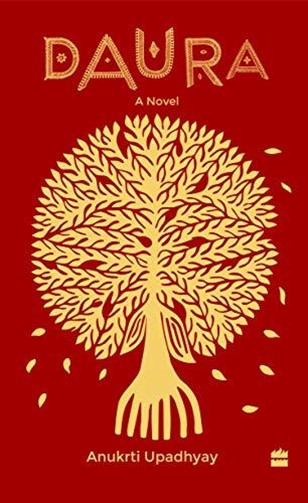Published July 1st, 2024
Review
by Namita Suberi
Anukrti Upadhyay, an author currently based in Mumbai, spins a web of mystery and illusion that perches precariously between reality and dream. Bhaunri and Daura, both published in 2019, are her first two works in English. The author has worked in both languages, Hindi and English, and finds it enriching to explore stories in both. It is this openness toward these languages that are so different from one another that gives Upadhyay's works a sense of whimsical dream that anyone could lose their way in.

When I picked up this novella, I was unaware of what I was getting into. It was a mistake to think this would be just a short, casual read to pass the time. Daura was one such book that made me question reality and kept me on the edge throughout.
The story is told in the form of recorded accounts and reports from people close to the District Collector (DC), who is posted to one of the furthest outposts of rural Rajasthan in India. He is young and idealistic and tours the small villages — dhanis — which are populated mostly by nomadic tribes. The title of the book encapsulates the entirety of the book in just a few letters that form a singular word — Daura. It signifies “both a tour and a bout of madness” as the protagonist's journey is both a tour of his inner self and, to others, outright insanity.
Daura is a magical, mystical story. The lore sometimes becomes part of reality connected to lost princesses, devs (male deities), and a human who apparently transcends to the divine.
To me, at its heart, Daura is also a feminist novella. The stories reveal the patriarchal norms ingrained deeply into the people and the community of the deserts of rural Rajasthan, especially the story about the lost princess does so remarkably well. Many men covet and want to possess her. However, she is adamant about not accepting any of them. In this regard, the DC often subverts the norms of the patriarchal community as he even gives the right of ownership of tribal land to the woman of the household, which, to many others, is unbecoming of the rules of their community. He is also one of the suitors who is forlorn and wants to find the princess. However, contrary to his counterparts, he doesn't covet or want to own the princess. Instead, he does something unexpected: He surrenders himself to her.
Thus, his transcendence, or madness in the eyes of the others, begins. He is found often under the huge tree, whispering and talking as though he has lost his mind.
“Perhaps that is so — the truth does not always take you forward, but it can help you see.”
I was utterly fascinated by two characters who represent two completely different worlds, and yet found harmony in their music: the District Collector and the Sarangiya. The former is from the cold and calculating world of the government, which is ensnared in politics and protocols. The latter is a nomad who travels from one place to another, plays his sarangi, and gives himself up to the vastness of the desert. He has no roots and no bounds.
“The Sarangiya was just the same that night, the same beauty and pain coursed around him as it always does.”

Yet, these two characters meet through their music, through the DC's flute and the Sarangiya's sarangi. The music is what bonds them enough for the Sarangiya to reveal the story about the princess, which, in turn, sets the District Collector on a path that the Sarangiya has trodden before. This meeting of two worlds is what keeps the story hinging between dream and reality, and the readers can't help but be drawn into it.
I was lulled into mysticism and magic while trying to make sense of what was going on with the plot. However, the more I tried to justify and rationalize the happenings, the more I was convinced that something supernatural was afoot. Towards the end, as I began to think that the magic would soon be revealed for all to see, the report of the Senior Superintendent of Police (SSP) ends everything with a dull thud as it repeatedly assures that all protocols and procedures have been duly followed. The innumerable colorful reports from various people, painting a whimsical and mystical picture of the events, which are represented in the symbol of the tree, are put to an end with the soulless bureaucratic axe of rules and protocol.
The novella seeks to let its characters breathe. It renders in such vividness the desert and its people that, long after I had turned the last page, I continued to wonder about the lost princess, the mysterious musician, and the human who may have become a god.
“You don't need to look for Collector Saheb. He has returned to the story he came from.”
Nationality: Bhutanese
First Language(s): Nepali
Second Language(s):
Dzongkha,
English
Supported by:


Comments on "Tale of Mystic and Madness: A Review of Anukrti Upadhyay's “Daura”"
Please log in to submit a comment.
Login